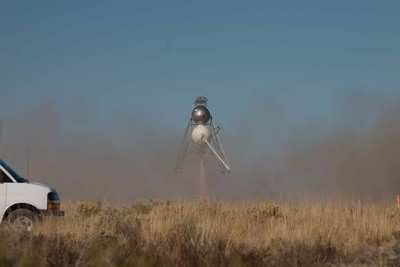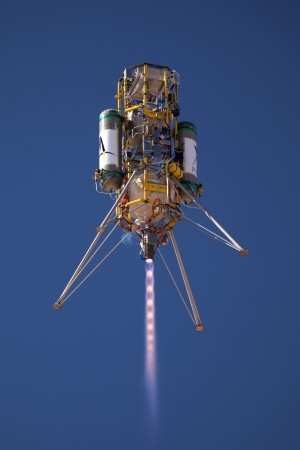Northrop Grumman Lunar Lander Challenge Enters Final Leg
 The race for the $2 million Northrop Grumman Lunar Lander
Challenge (NGLLC) incentivized prize purse, funded by NASA and
presented by the X PRIZE Foundation, is coming down to the wire. As
the competition end date (Oct. 31) draws near, teams will descend
upon the Mojave Desert in a head-to-head showdown to compete for
portions of the remaining $1.65 million prize purse. Officials have
confirmed that at least $1.15 million will be awarded this year to
a minimum of two of the four NGLLC teams. This will be the largest
incentivized prize awarded by the X PRIZE Foundation since the 2004
Ansari X PRIZE competition.
The race for the $2 million Northrop Grumman Lunar Lander
Challenge (NGLLC) incentivized prize purse, funded by NASA and
presented by the X PRIZE Foundation, is coming down to the wire. As
the competition end date (Oct. 31) draws near, teams will descend
upon the Mojave Desert in a head-to-head showdown to compete for
portions of the remaining $1.65 million prize purse. Officials have
confirmed that at least $1.15 million will be awarded this year to
a minimum of two of the four NGLLC teams. This will be the largest
incentivized prize awarded by the X PRIZE Foundation since the 2004
Ansari X PRIZE competition.
"The Northrop Grumman Lunar Lander Challenge has turned into a
real horse-race. There is $1.65 million up for grabs that will be
decided in the next 10 days," said Dr. Peter H. Diamandis, chairman
and CEO of the X PRIZE Foundation. "It is getting very exciting and
is worth everyone watching. The ultimate winners will be all of the
teams in this emerging industry, NASA and the space-passionate
public."
The NGLLC is comprised of two levels; each level includes both
first and second place prizes. The $350,000 first-place prize for
Level 1 went to Armadillo Aerospace at last year's competition. The
remaining prizes include the second-place prize for Level 1 worth
$150,000, and the two prizes for Level 2 worth $1 million and
$500,000.
"When this prize was first announced, there was hardly any work
being done in this important field of rocketry," noted William
Pomerantz, Senior Director of Space Prizes of the X PRIZE
Foundation. "To have a situation where we are judging
back-to-back-to-back launch attempts by three different teams,
especially on the heels of the impressive flights put on by
Armadillo, Masten, and TrueZer0 previously, is absolutely
astounding. We're witnessing the birth of a new sector of the
industry, and NASA, the US government, and private customers are
all going to benefit."
On Sept. 12, Armadillo Aerospace, led by id Software founder
John Carmack, successfully completed the requirements for the Level
2 NGLLC prize purse. The criterion for Level 2 requires the rocket
to simulate a full lunar lander mission. The flight profile must
closely simulate the task of descending from lunar orbit to the
lunar surface, refueling and returning to lunar orbit. To match the
performance of such a mission here on Earth, the vehicle must
ascend to a height of 50 meters, translate horizontally to a
landing pad 50 meters away, land safely on a rocky lunar-replica
surface after at least 180 seconds of flight time and then repeat
the flight by returning to the original launch site. The Armadillo
team flew its lunar lander rocket vehicle, "Scorpius," twice in two
hours, flying between a pair of landing pads to qualify for the top
prize. The two flights of Scorpius, which weighs about 1900 pounds
when fully loaded with its ethanol and liquid oxygen propellant,
launched from the Caddo Mills Municipal Airport in Texas, where
Armadillo Aerospace's facilities are based.

On Oct. 26, BonNovA, led by Allen Newcomb, will attempt to
qualify for the second place prize of the Level 1 portion of the
NGLLC. BonNovA's vehicle, Lauryad 1, will launch from Cantil,
California using propane and N2O as its propellant. The
requirements of Level 1 of the competition challenge teams to
simulate a lunar mission and complete two successful flights, with
the rocket rising to 50 meters, translating over to a second
landing pad, and remaining in the air for at least 90 seconds. The
following day, BonNovA will attempt to successfully complete the
requirements of Level 2 of the NGLLC with its Lauryad 2
vehicle.
On Oct. 28 and 29, Masten Space Systems, directed by David
Masten, will attempt to complete the requirements for the Level 2
mission, which would also put them in the running for the $1
million prize. The team's rocket, XA0.1E, also called "Xoie,"
weighs about 850 pounds when fully loaded with its isopropyl
alcohol (IPA) and liquid oxygen propellant. It will launch from the
Mojave Air and Space Port in California. On Oct. 7, the Masten team
completed the requirements of Level 1 of the NGLLC qualifying for
the second-place prize of $150,000. The rocket launch was their
second attempt at a Level 1 challenge as the team made an effort on
Sept. 16.

Also in the race is Unreasonable Rocket, a father and son team
managed by Paul Breed. The Unreasonable team will attempt the Level
1 portion of the challenge on Oct. 30 with its "Burning Splinter
90" rocket, also called "the blue ball." They will be launching
from Cantil, California. On Oct. 31, the Unreasonable team will
make its first attempt at the Level 2 portion of the challenge with
its "Burning Splinter 180" vehicle, also called "the silver ball."
Both lunar lander vehicles use a Hydrogen Peroxide bipropellant as
the propellant. October 31 is the final day available for flights
this year. Should any prize money remain after these attempts,
teams will need to wait until 2010, the final year of the program,
to try again.
The ultimate goal of the NGLLC is to inspire entrepreneurs who
can enable a new era of commercial exploration. These milestone
events within the privately funded space sector continue to
demonstrate the value of prizes and how they stimulate innovation.
The successful flights from all of the private space companies
continue to underscore the report to President Obama by the
Augustine Commission, which called for increased commercial sector
participation both in orbital operations and NASA's efforts to
reach the Moon by 2020. Now, more than ever the time is right for
private industry to supply NASA with hardware and services to
enable suborbital, orbital, and lunar exploration.
 ANN's Daily Aero-Linx (04.16.24)
ANN's Daily Aero-Linx (04.16.24) Aero-News: Quote of the Day (04.16.24)
Aero-News: Quote of the Day (04.16.24) Airborne 04.10.24: SnF24!, A50 Heritage Reveal, HeliCycle!, Montaer MC-01
Airborne 04.10.24: SnF24!, A50 Heritage Reveal, HeliCycle!, Montaer MC-01 Airborne 04.12.24: SnF24!, G100UL Is Here, Holy Micro, Plane Tags
Airborne 04.12.24: SnF24!, G100UL Is Here, Holy Micro, Plane Tags Airborne-Flight Training 04.17.24: Feds Need Controllers, Spirit Delay, Redbird
Airborne-Flight Training 04.17.24: Feds Need Controllers, Spirit Delay, Redbird




